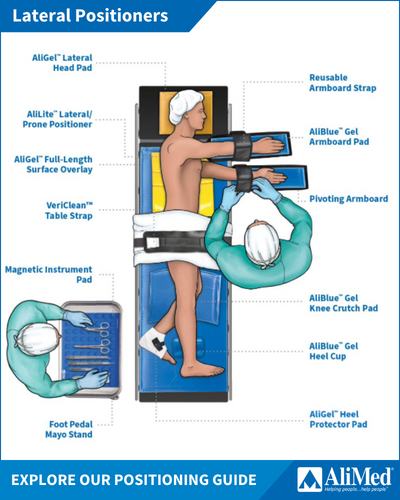-
Home
-
Proper Patient Positioning Guidelines: Lateral Position
Proper Patient Positioning Guidelines: Lateral Position
August 14, 2023

The lateral position, also known as the lateral decubitus or lateral recumbent position, is when a surgical patient is positioned with the non-operative side placed on the operating room table. It is most commonly used for surgical procedures involving the thorax, kidney, or hip.
As with any surgical position, positioning a patient in lateral can place pressure on various parts of the patient’s body. These areas generally include the side of the face and ear, acromion process, axilla, olecranon, iliac crest, greater trochanter, lateral knee, malleolus, and feet. In addition to pressure injuries, other safety concerns during lateral may include tissue or nerve damage or musculoskeletal injuries due to improper positioning.
Proper alignment, adequate stabilization, and support of extremities with sufficient padding can help minimize integumentary, circulatory, and musculoskeletal injuries. The perioperative team must be trained in good positioning techniques. However, even the most ideal techniques can result in pressure or tissue damage when makeshift or improper positioning equipment is used.
In this article, we will review proper patient positioning techniques in lateral to help prevent positioning injuries and some of the key surgical positioning products used to support and stabilize the patient while minimizing pressure risk, skin shear, and nerve injuries.
Positioning the Patient in Lateral: Head and Neck
Note: Prior to positioning a patient for surgery, perioperative nurses or the surgical team initially perform a preoperative risk assessment so that all risk factors and any specific patient needs and requirements are identified to ensure safe positioning.
In lateral, the patient is positioned on their non-operative side with the head elevated to align with the spine. A lateral head pad can be used to position the patient’s head and protect the head and face against nerve and pressure compression. Use of a horseshoe head donut can help reduce the risks of ocular pressure by offloading the area.
Positioning the Patient in Lateral: Arms and Upper Body
When positioning the upper body, the upper and lower arms are typically secured on separate, parallel armboards in front of the patient with both arms abducted. A pivoting armboard can help achieve the right positioning angle and armboard pads provide added anti-shear protection for the bicep, elbow, and forearm areas.
Once positioned on the armboards, arms should be secured to armboards using positioning straps. Reusable armboard straps with a broad surface area can help reduce pressure points on the arm. Precut single-use straps are disposable options to aid with infection control and faster room clean up.
Axillary rolls are also critical positioning tools. They are placed under the patient’s dependent thorax to help support the shoulder, redistribute weight, and prevent brachial plexus compression.
Positioning the Patient in Lateral: Legs and Lower Body
When positioning the lower body, the patient’s dependent leg should be flexed at the hip and knee. The upper leg should be straight and supported with a pad or positioner placed between the legs. The dependent knee, ankle, and foot should also be padded to relieve pressure on any bony prominences.
Lateral positioning devices can also be used to comfortably secure patients and prevent them from rolling for total lateral stability. Options with fully adjustable posts or pads can be positioned or angled based on the patient’s body and locked for precise positioning. Bean Bag Positioners may also be used and feature loosely packed beads that conform to the patient’s body for safe, stable positioning.
In general, supports should not press against the abdomen to avoid impairing venous drainage from the lower limbs.
More Resources for Lateral and other Surgical Positions
AliMed has a wide range of reusable and disposable surgical positioning products to aid with proper patient positioning while helping reduce pressure, shear, and nerve injuries during lateral procedures.
Explore our interactive Lateral Positioning Hub or browse our comprehensive guide for more patient positioning products and resources for lateral and other common surgical positions, including supine, prone, lithotomy, Fowler’s, Trendelenburg, reverse Trendelenburg, and spinal.